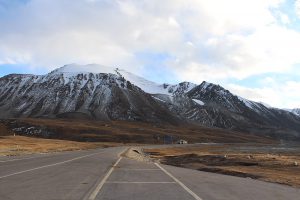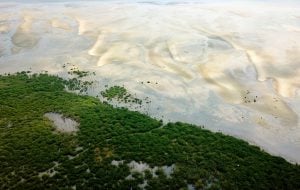Habitat loss and poaching, in the tiny Himalayan kingdom of Bhutan, is slowly driving some of the lesser known, yet critically endangered species like pygmy hogs, pangolins and hispid hares, to extinction. Although listed as ‘totally protected wild animals,’ under Bhutan’s forest and nature conservation act, these species have not received much attention and the challenges they face are not well understood.
Pygmy hogs, (Porcula Salvania) also listed by the IUCN (International Union for Conservation of Nature), as a ‘critically endangered’ species is now believed to be extinct in Bhutan. There are estimated to be less than 250 individuals globally, mostly on the Indian side of the Manas wildlife sanctuary that borders southern Bhutan. Despite two separate studies in 2009 and 2014, no records were found about their existence in Bhutan.
Considered an important indicator species, pygmy hogs help maintain the health of the grassland ecosystem by digging the ground and enriching the soil.
Most environmentalists said lack of funding is a major challenge. Much of the funding for species conservation in Bhutan comes from international donors. These are mostly directed more charismatic species like tigers and snow leopards while the likes of pygmy hogs are effectively left out.
Vijay Moktan, director of conservation with the World Wildlife Fund (WWF-Bhutan) said that these critically endangered species might have become, ‘functionally extinct,’ which happens when the number of species is too small to re-produce and sustain future generations. Due to a serious lack of funding, much of the studies on these species have been limited to social surveys and ground observations, with few camera traps.
Pygmy hogs live in narrow strip of grasslands that pass across the 1,057 square kilometre Royal Manas National Park (RMNP) in Bhutan and the Manas National Park in India. Considered an important indicator species, pygmy hogs help maintain the health of the grassland ecosystem by digging the ground and enriching the soil. They also keep a check on certain worms and insects that destroy plants.
The 2014 study to assess the population status of pygmy hogs in RMNP did not find any signs of the species, and concluded that large swathes of the species’ habitat have been lost over the years. In the last three decades, more than 50 percent of the grassland area, inside the RMNP has disappeared. This, environmentalists think, could have led to the loss of the species.
Tshering Dorji, Senior Park Ranger at RMNP said an in-depth, thorough and comprehensive study of the species and its habitat use is urgently required, to suggest proper management interventions and species recovery plans. Only then can such species be saved from extinction. “But without financial support, it is not possible,” he added. There is little scope for funding from within Bhutan, the only potential funders within Bhutan are Bhutan Trust Fund for Environment and WWF but their scope is limited. Bhutan launched an impressive funding plan for its conservation areas, with government funds and international donors, but this does not specifically look at such endangered species.
Across the border in India, a captive breeding centre for the species have been recently established, where young pygmy hogs, carefully trained and habituated in simulated environments are being released into the wild. In Bhutan, environmentalists are hopeful that with proper habitat management, these species might migrate over to Bhutan, because their home range overlaps across the RMNP in Bhutan and the Manas Park in Assam, India. The rich grassland ecosystem in the park area is also largely used by other endangered species like tigers, rhinoceros, elephants, water buffalos and hispid hares.
See: The pygmy hog: to the brink of extinction and back
Of the Hispid hare and other endangered species
Hispid hares, another critically endangered mammal species, share the same habitat with pygmy hogs and are endemic to only certain locations in southern Nepal, Bhutan and northeast India. In 2015, Tshering Nidup, senior range officer with Phibsoo Wildlife Sanctuary carried out a field survey with camera traps and recorded around eleven images in the RMNP.
But there is not enough data and the number of hispid hares in Bhutan is unknown. Tshering Nidup said, uncontrolled burning of grasslands has affected many parts of the habitats, and it usually happens during the species’ birthing seasons. The controlled burning within Bhutan takes place within February, but across the border in India it starts around January is much more random. In Bhutan controlled burning is carried out to enable new shoots to grow, so that it enriches the habitat, but the impact on species that have little care for a border cannot be managed in one country alone. Since not much has been studied, environmentalists have limited knowledge on the species’ behaviour, distribution, habitat use, feeding habits and their role in the ecosystem.
![Pangolin in a cage. The pangolin is the most trafficked species on the planet [image by: Sandeep Kumar]](https://dialogue.earth/content/uploads/2019/05/Dr-Sandeep-Kumar-2-1.jpg)
Habitat loss and poaching is also becoming a serious threat to other species like the pangolin, a scaly ant-eating mammal, one of the least known and scarcely heard about creature in Bhutan. Globally, the species is being hunted to extinction. Poaching is the second biggest threat to wildlife conservation in Bhutan, after habitat loss. Tshering Dorji said that there are no cases reported of pangolins being poached. “But I am pretty sure, they are being hunted,” he said. Much of pangolin poaching is driven by trade to China, but there is no direct route from Bhutan that could be used for such activities. Since there is little investigation on the state of the mammal this issue is critically understudied.
Pangolins are found mostly in the southern districts of Samtse and Dagana. A highly prized mammal in the international illegal market, IUCN in 2014 stated that pangolins are the most illegally traded mammals in the world with more than one million individual pangolins believed to have been killed in the last decade.
In some communities in Bhutan, pangolins are regarded as symbols of bad luck. Mostly nocturnal, they are rarely seen during the day and have been spotted in elevations till 1,800 meters from the foothills of Bhutan.
Tshering Nidup said most people in the communities are unaware of the species; hence it is important to educate them on the value and role they play in the environment. Today, Tshering Nidup, with funding from Mohamed Bin Zayed Species Conservation Fund, is carrying out a more detailed study using radio collars and tags. “But we are not able to get hold of the creature and have to innovate trapping methods to catch the species,” he said.
On the other hand the Himalayan musk deer, although a relatively well-known endangered species, is being continuously threatened by large-scale organised poaching. Phub Tshering, senior forest ranger with the forest protection and surveillance section (FPSS), said that hundreds of snares and traps are dismantled every year by foresters, and they are only a small fraction of the whole. “Earlier, poaching used to be restricted to only certain regions of the country, today there are poachers from everywhere,” he said.
Data is crucial
Without reliable data and other crucial information, coupled by a serious lack of financial resources, these lesser-known critically endangered species will likely become extinct soon, said Rebecca Pradhan, senior Ecologist with the Royal Society for Protection of Nature (RSPN). As one of the top contributors to Bhutan’s environmental conservation efforts, Rebecca said conservation requires extensive studies and multi-pronged approaches, while taking account of all the stakeholders of the ecosystem including human settlements.
Bhutan has good laws, policies, and rules and regulations, but if other socio-economic factors are not addressed, they will not work. For example, communities with limited source of income are forced to hunt and fish in endangered species’ habitats, because they have no choice, she said.
Officials from the nature conservation division said, through funds received for tiger conservation, environmentalists also try to cover other species in their studies, along the process. Senior forestry officer Tandin said that due to the pressures of prioritising at the national level only a minimum funding is available for specific species.
Planning for the future
To address this disparity in the level of importance accorded to various endangered species, the ministry of agriculture is working to create a nation-wide biodiversity monitoring system to study species concentration, distribution and habitat types by using different monitoring methods and techniques on different species. “This will provide us the necessary data to come up with an inclusive conservation plan and in the future, the data can be used to identify trends and changes in species population, distribution and habitat use,” he said.
Bhutan’s agriculture minister Yeshey Penjore said the policy does not discriminate, but due to a lack of funding and limited knowledge about these species, environmentalists are forced to overlook these species. “They must receive equal treatment, and we are working towards that,” said the minister.
But just when the country is in dire need of critical funding to save these species from imminent extinction, foreign aid is expected to decline as Bhutan graduates from a low income to a middle-income country soon.
![<p>The successful breeding of the pygmy hog in captivity has been key success [image by: Pygmy Hog Conservation Programme ]</p>](https://dialogue.earth/content/uploads/2018/04/pygmy-hog-3.jpg)







![Phuentsholing Gas Station in Bhutan. Petrol stations create problems of emissions in a country too dependent on cars [image by: Omair Ahmad]](https://dialogue.earth/content/uploads/2020/01/Phuentsholing-Gas-Station-300x225.jpg)